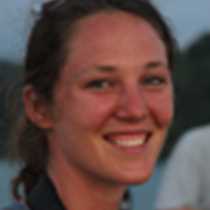Panama Bay Islands and the Panama Canal
As the National Geographic Sea Lion made her way along the coast of the Gulf of Panama this morning, we were treated with a beautiful sunrise that lit the sky red, orange and yellow. Morning stretch on the aft bridge deck was followed by a fresh smoothie and breakfast buffet.
After breakfast, we had time to relax and enjoy the morning sun before the crew set anchor just off shore of two unique islands – Isla Otoque and Isla Bona. The waters that surround these islands are extremely nutrient rich due to an upwelling of deep ocean currents. This upwelling results in an extremely high productivity that draws a high concentration of nesting seabirds and predatory migrants. We spent the morning exploring the islands by Zodiac, watching the sleek and fast magnificent frigate birds as they tried to steal fish from the beaks of slower blue and brown-footed boobies and brown pelicans. Frigate birds are known as kleptoparasites because they very rarely catch their own food. Instead, they wait for a booby or a pelican to pluck a fish from the water. Then they swoop in and try to make their victim drop its catch. The feathers and bone structure of a frigate bird are not well adapted to living near the sea. If they get wet, then it’s very difficult for them to fly, so they rely on other birds to catch their prey. A handful of us were fortunate to witness a Peregrine falcon with a freshly killed brown booby. We didn’t see the kill, but we saw the falcon try to drag its prey off the rocky shoreline to a better hiding place, where it could feed without worry of an ambush.
As the sun was beating down relentlessly, we had the opportunity to cool off before lunch by swimming from the fantail. The water felt refreshing after an hour of bird-watching from the black Zodiacs! During lunch we picked up anchor and continued our journey through the Gulf of Panama. It was only 22 nautical miles to the Pacific entrance of the Panama Canal and we arrived around 15:00 (or 3:00). We had to tie up at our buoy and wait for the Canal Administration to inform us of our transit time, but it wasn’t long before the Canal pilot arrived and we were on our way. The first lock we passed through was Miraflores, and we watched from the decks as the line-handlers navigated us through the tight concrete walls of the lock. After dinner we came to our second lock, called Pedro Miguel, which along with the Miraflores lock, lifted us up 90 feet above sea level and into Gatun Lake where we will be anchored for the night. As the highlight of the trip for many, it was exciting to finally enter into the historic Panama Canal!




